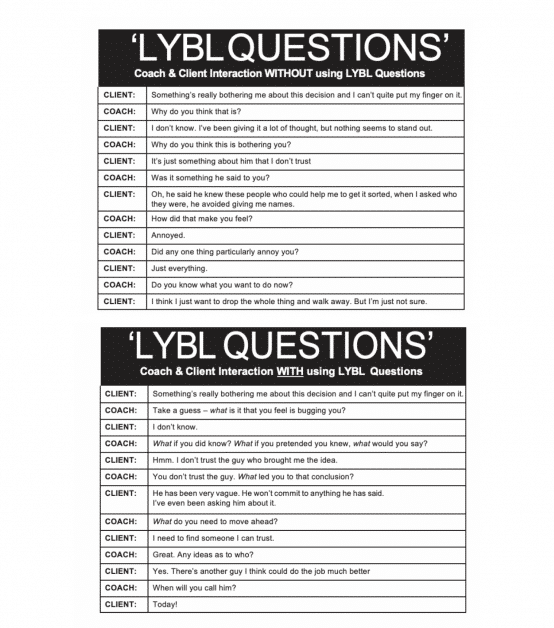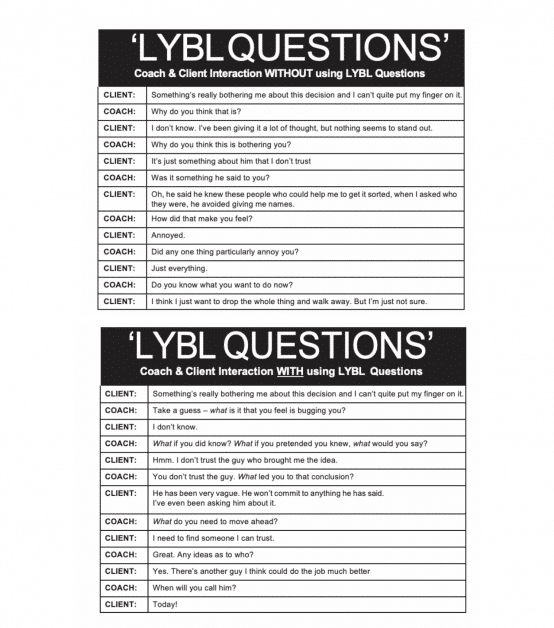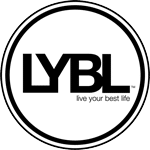HOW & WHEN TO USE ‘LYBL QUESTIONS’?
Imagine 2 friends conversing and empathising over a problem.
One is expressing a complaint and the other is taking the supportive role.
If the supporter was to ask information questions – “Where were you?”, “Who started it?”, “Why?”, They would be treated to details about who did what to whom in a blow-by-blow re-enactment of the drama.
However, if the supporter knew how to ask ‘LYBL QUESTIONS’, “What is upsetting about what happened?” The friend with the problem would move from problem to solution in record-breaking time.
And that I believe is key here.
For you to be able to move from ‘problem’ to ‘solution’ as quickly and resourcefully as possible.
So that you can find the appropriate ‘what’ questions to ask, you must change the focus from the details and information and bring to light the desired outcome, potential outcome and all the areas of possibility.
Move away from trying to understand a problem and move toward solving it. In the process, you’ll see that you don’t really need to understand the dilemma to know how to solve it. Using ‘what’ questions will train you to think towards the future, as if you are already ahead of the problem.
‘What” assumes that a solution is the goal, to the exclusion of everything else. It always finds a way.
Sometimes, we want to be left alone with our problems for a while.
Have you ever tried to help a friend who didn’t really want help?
Remember how frustrated that left you feeling? When you or someone you know wants to continually keep reflecting on a problem over and over again, with no real desire to solve it, in this instance, all the ‘LYBL QUESTIONS’ in the world are not going to help. You must truly want to stop the record from spinning round and around in circles and desire for the problem to be solved if ‘what’ questions are to have their desired outcome and effect.
Even though you can do this by yourself, I believe it is really powerful to play witness and be a part of seeing other people gain clarity when you ask them ‘what’ questions.
Asking ‘LYBL QUESTIONS’ is a productive and highly generous listening tool for you to use with friends, colleagues and loved ones. Allowing another person to hear themselves is a wonderful gift. This kind of thoughtful communication takes time and patience to master, and as you do so, you will find that it deeply improves the quality of all your relationships.
So, whether you use ‘LYBL QUESTIONS’ to move yourself or someone else forward, keep in mind that you now have a great, simple and efficient tool.
All these reasons mentioned above are why I choose to use ‘LYBL QUESTIONS’ with my clients. It truly enables them to create more positive circumstances and to move toward their outcomes more quickly than they do on their own. These questions alone predictably set clients up for both small and large breakthroughs. The best part is that it is my clients who already have the answers within them; I am simply there asking the right questions, prompting them in order to accelerate their own self-discovery mission.
Nothing makes me happier than when I hear a client say, “Thats a good question.” Or better yet, “I hate you for asking that!” Those are surefire signs that we have struck pure gold – the gold that I call their innate widsom. These are the boundary conditions that you know need to be crossed in order to have them explore new territory. I call it the territory of possibility. This is where anything becomes possible.
Now that you are ready to start using ‘LYBL QUESTIONS’, let’s get question asking to work for you.
Don’t focus too much on the need to be right, simply run off the principles of asking ‘what’ instead of ‘why’. As with everything, the more you do it, the more familiar it will become.
Below you will see two conversations that cover the same subject matter, yet with dramatically different results:


In the first conversation, you’ll see the coach speak with a client in a more conventional way, WITHOUT using ‘LYBL QUESTIONS’.
The coaches questions asked in the first conversation focus on information seeking, and in such a non-specific way that the client isnt prompted to provide dynamic answers that would propel them forward. There is no freedom from the problem, no break from its burden, no movement toward a solution.
And from my experience, this is how most interactions play out!
No wonder people feel stuck and frustrated!
Now compare that to the second example, where the coach uses ‘LYBL QUESTIONS’.
Now we’re talking…. clarity, relief, action, and a way forward.
Here, the client’s answers are dynamic, empowering and they ring with certainty.
Wisdom is attained and, with it, as break from the burden of the problem.
This liberating break is the result of using ‘LYBL QUESTIONS’.
Now its time for you to get to work and practice what you’ve learned over the next 24 hours.
Download the attached activity full of LYBL questions that you can use & a place to record your experiences.
Yours in best life living,
MJ x

